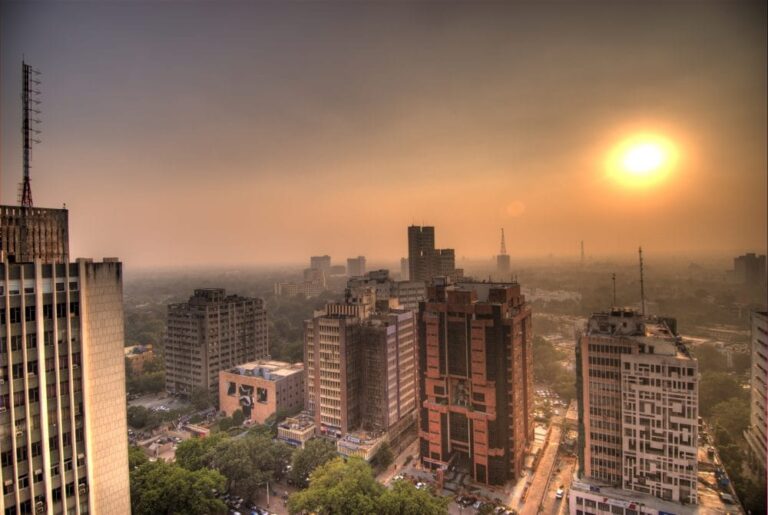
Image credit: By Ville Miettinen from Helsinki, Finland (Connaught Place sunset) [CC BY 2.0 (http://creativecommons.org/licenses/by/2.0)], via Wikimedia Commons
A study mapping cooling energy consumption found individuals living in urban households in the Delhi-National Capital Region (NCR) often purchase air conditioners on the basis of the brand, features and price points, rather than energy efficiency. The survey of 2,092 households in the NCR -the Indian region with the highest level of electricity consumption – sought to understand the range of energy and cooling technology purchased, use and maintenance specificities, demographic and socioeconomic characteristics, and consumer motivation.
Researchers found that 43 percent of the households surveyed own one air conditioner, while eighteen percent in the same neighbourhoods own only a fan. Within this, there was a notable display of inefficient purchases, with 78 percent of air conditioner-owning households possessing at least one energy-efficient air conditioner. The majority of air conditioners were rated 2.8 on an ascending one to five scale ranking energy efficiency, as per standards unveiled by the Ministry of Power in 2006.
Relationship between consumer behavior and climate change
Whilst Satish Kumar, an expert in the field of thermal cooling and president and executive director of the Alliance for an Energy Efficient Economy, points out there is a lack of evidence underpinning the motivation behind purchases of inefficient air conditioning, one potential reasoning may lay in the results of the study published in Environmental Research Letters. The study details the trappings of living in a warming world, one where consumers will make choices that are perhaps not considerable of the complex climate relationship that is also involved and recognising that there may be alternative options.
But for this to hold true there needs to be those options. As The Guardian noted in a column examining reliance on air conditioning, “one step towards solving the problem presented by air conditioning – and one that doesn’t require a complete overhaul of the modern city – would be to build a better air conditioner. There is plenty of room for improvement.”
Arguably, some of that improvement exists based on the Union Power Ministry energy ranking scale, although consumers fail to examine the behavioral changes that are worth doing, some of which are inextricably linked to purchasing habits.
Progressing consumer choices
Moving forward, there is clearly a vacuum for better communicating the relationship between consumer choices and the environmental impact. Radhika Khosla, co-author of the study entitled ‘The what, why, and how of changing cooling energy consumption in India’s urban households’, said “awareness of energy-efficient schemes and intervention campaigns will be key to purchase decisions. Households that are better informed about available schemes, purchase more efficient technologies and also use them more efficiently.”
Alongside this, there is a key role for policymakers to play. They must create an increased range of energy efficient and low carbon choices, a factor that is highly important for a country that has been so historically reliant on coal power. As Health Issues India recently reported, India’s divestment in coal still appears to be a work in progress at best with a draft policy document viewed by Reuters showing India is open to the possibility of further developing its fleet of coal-fired power plants as they generate the cheapest power. This is despite ample room for investment into renewable, decarbonised energy. As Health Issues India previously noted, “global investors ready to invest hundreds of billions of dollars in the country’s decarbonisation industry. For India to meet its renewable energy goal by 2030, it will need US$500 billion of investment over the next decade.
“The roadmap towards this is looking increasingly plausible, with India now the centre of attention for a number of global energy giants looking to diversify their renewable energy portfolio, according to analysis from the Institute for Energy Economics and Financial Analysis (IEEFA).”
There is also scope for tailored tariffs throughout the day since air conditioning technology is most commonly used during the night. Such a change could help suppress usage during afternoon and night-time peak demand. For example, peak hours between 2 pm and 5 p.m attract a twenty percent surcharge.
For India to achieve tangible change in an area that spans the breadth of policy, economics, and the environment that is collaborative work to be done. This includes, but certainly is not limited to, work on the pricing of efficient cooling systems, changing entrenched opinions on how to make future savings on such technological systems, and also imparting knowledge on the clear value these decisions can have long-term. As Sunil Dahiya, an analyst with the Centre for Research on Energy and Clean Air, told Health Issues India in an interview, “we are all stakeholders in this.” The fight for environmental justice and reform depends upon all of us to make informed choices. Among such choices is the need to think about energy efficiency – and so awareness-raising and innovation to ensure affordable energy-efficient systems is vital.

